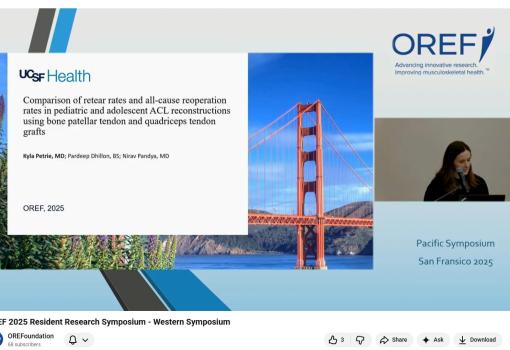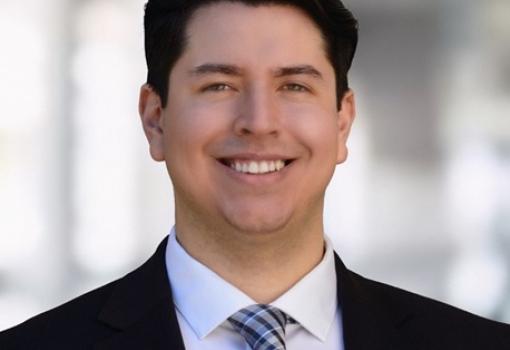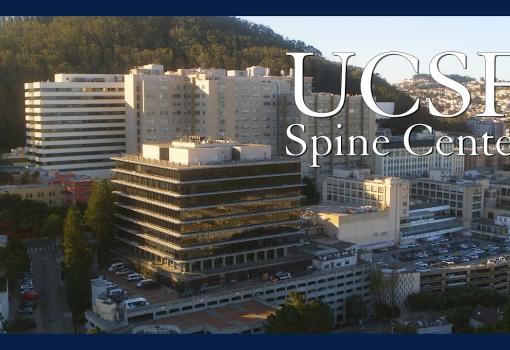Dustin Snapper, MD, MS

Dustin Snapper, MD, MS
Orthopaedic Trauma Institute at Zuckerberg San Francisco General - Trauma & Problem Fractures
About Dustin Snapper, MD, MS
I am currently a Full Specialist at the University of California, San Francisco in the Department of Orthopaedic Surgery, Orthopaedic Trauma Institute. My long-term career goal is to work creatively in biomedical research, with a particular interest in regenerative medicine and tissue engineering as it relates to addressing potential therapies to treat human disease. Currently, my research focuses on the translational applications of endochondral fracture repair by understanding the mechanisms of endochondral ossification and using novel therapeutics and bioactive material platforms that promote bone regeneration. I have a broad background in traumatic brain injury, biomarker discovery (miRNA and proteins), human stem cell 3D cultures, animal surgery, and project leadership. I received an M.D. degree from West Virginia University School of Medicine and then completed a general surgical internship at Charleston Area Medical Center. In addition, I obtained a Master of Science degree in biomedical engineering at Case Western Reserve University. I completed two post-doctoral fellowships, one at the FDA in the Vascular Biology Laboratory and the second at the Uniformed Services University in the Department of Pharmacology. At the FDA, I studied the functional effects of nickel chloride and nickel-titanium (nitinol) nanoparticles, commonly used as a component of vascular stents and metal-on-metal hip implants, with relevance to biocompatibility and the effects of angiogenesis leading to implant failure. At the Uniformed Services University, I conducted research on the effects of blast-induced traumatic brain injury. I utilized a novel bioengineered 3D brain-like tissue for identifying biomarkers of primary blast-induced traumatic brain injury. I also studied the role of angiotensin-(1-7) in mediating the radio-protective effects of captopril and performed transcriptomic analysis of mouse brains after traumatic brain injury. My research has been published in several peer-reviewed journals and has been presented in several scientific conferences.
Publications:
Snapper, D. M., Reginauld, B., Liaudanskaya, V., Fitzpatrick, V., Kim, Y., Georgakoudi, I., Kaplan, D. L., & Symes, A. J. (2022). Development of a novel bioengineered 3D brain-like tissue for studying primary blast-induced traumatic brain injury. Journal of Neuroscience Research, 101(1), 3–19. doi:10.1002/jnr.25123. PMID: 36200530.
Srivastava, A. K., Snapper, D.M., Zheng, J., Yildrim, B. S., Srivastava, S., & Wood, S. C. (2022). Examining the role of nickel and NiTi nanoparticles promoting inflammation and angiogenesis. Journal of Immunotoxicology, 19 (1), 61-73. https://doi.org/10.1080/ 1547691X .2022.2080307. PMID: 35901199.
Attilio, P.J. † , Snapper, D.M. † , Rusnak, M., Isaac, A., Soltis, A.R., Wilkerson, M.D., Dalgard, C.L., and Symes, A.J. (2021). Transcriptomic Analysis of Mouse Brain After Traumatic Brain Injury Reveals That the Angiotensin Receptor Blocker Candesartan Acts Through Novel Pathways. Front. Neurosci. 15:636259. doi: 10.3389/fnins.2021.636259. PMID: 33828448. † Co-first author
Cui, X., Cao, Z., Sen, G., Chattopadhyay, G., Fuller, D. H., Fuller, J. T., Snapper, D.M., Snow, A., Mond, J.J., Snapper, C. M. (2013). A novel tetrameric gp3501-470 as a potential Epstein-Barr virus vaccine. Vaccine, 31(30), 3039–3045. doi:10.1016/j.vaccine. 2013.04.071. PMID: 23665339.
Snapper, D.M., Kureshi, S., Maupin, K. (2012). Case report of Swyer-James Syndrome: An incidental finding of unilateral, hyperlucent lung. Chest, 142:1022A. doi: 10.1378/chest 1386617.
Zang, Y., Savvidou, M.T., Liaudanskaya, V., Singh, P., Fu, Y., Nasreen, A., Coe, M., Kelly, M., Snapper, D., Wagner, C., Gill, J., Symes, A., Patra, A., Kaplan, D., Beheshti, A., Georgakoudi, I. (2024). Synergistic label-free fluorescence imaging and miRNA studies reveal dynamic human neuron-glial metabolic interactions following injury. Science advances, 10(50), eadp1980. https://doi.org/10.1126/sciadv.adp1980.
Duke, V.R., Philippon Jr., M.J., Lind, D.R.G., Kasler, H., Yamaura, K., Czachor, M., Nelson, A.L., J., Brown, J., Garcia, A., Hambrigh, W.S., Huard, J., Marcucio, R.S., Snapper, D.M., and Bahney, C.S. (2024). Murine Progeria Model Exhibits Delayed Fracture Healing and Elevated Local Immune Response. Journal of Orthopaedic Translation. Manuscript Submitted.
Preprint available: https://www.biorxiv.org/content/10.1101/2024.05.29.596277v1


